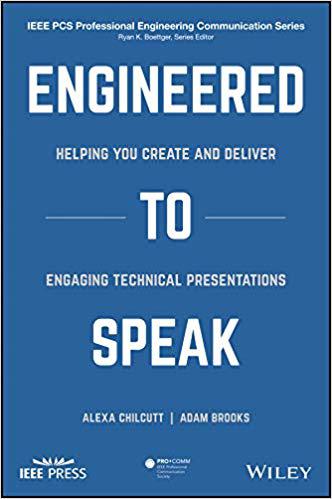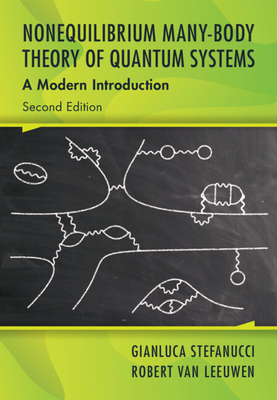图书简介
Engineered to Speak: Helping You Create and Deliver Engaging Technical Presentations Technical expertise alone is not enough to ensure professional success. Twenty-first century engineers and technical professionals must master making the complex simple and the simple interesting. This book helps engineers do what they love most: take a complicated system and create a stronger solution. You will learn tips and strategies that help you answer one essential question, "How can I get better at sharing my ideas with a variety of audiences?" In Engineered to Speak, Alexa Chilcutt and Adam Brooks combine their expertise in messaging and public speaking with research that illustrates how effective communication contributes to career advancement. Each chapter contains inspiring stories from practicing engineers around the world as well as useful examples, exercises and repeatable processes for creating compelling messages. This book helps technical talent become better speakers, better communicators, and ultimately better leaders. This helpful guide demystifies the art of oral communication by breaking it down into ten easy-to-follow-processes that can improve the ability of professionals at any level. By the end of Engineered to Speak, you’ll understand how to gain buy-in, identify and expand your Sphere of Influence, amplify your message, deliver compelling presentations, and learn from those who’ve embrace these skills and enjoyed professional success.
A Note From Series Editor xi About the Authors xiii Acknowledgments xv PART I: RECOGNIZE COMMUNICATION OPPORTUNITIES 1 WHY THIS BOOK? 3 1.1 Why Now? 5 1.2 Managers 6 1.3 Engineers and Technical Professionals 6 1.4 Students 7 1.5 Embracing Your Power as a Presenter 7 1.6 How to Use this Book 8 1.7 Calls to Action 9 2 DEMYSTIFYING COMMUNICATION AND ENGINEERING 11 2.1 The Place to Start 12 2.2 Rejecting Stereotypes 13 2.3 Debunking the Myths 14 2.3.1 Myth 1: Good Communicators Are Not Anxious 14 2.3.2 Myth 2: Some People Are Naturally Great Speakers 15 2.3.3 Myth 3: Winging it Works 16 2.3.4 Myth 4: Need to Be the \"Sage on Stage\" 16 2.3.5 Myth 5: Data Is Supreme 17 2.3.6 Myth 6: Time - I Must Fill It 17 2.3.7 Myth 7: Extroverts Make Better Speakers 18 2.4 Calls to Action 18 2.4.1 Communication Assessment Questions 18 2.4.2 Level of Anxiety in Public Speaking Situations 19 2.4.3 Putting Knowledge into Practice 20 3 RECOGNIZING COMMUNICATION OPPORTUNITIES 23 3.1 The Sphere of Influence Model 24 3.1.1 Internal Interactions Quadrant 25 3.1.2 Leadership Interactions Quadrant 26 3.1.3 External Interactions Quadrant 27 3.1.4 Personal Interactions Quadrant 28 3.2 Communicating to Connect 28 3.3 Listening Hang ]Ups 29 3.4 Active Listening Tactics 31 3.4.1 Paraphrasing 31 3.4.2 Priming 31 3.4.3 Expressing Understanding 31 3.4.4 Use of Nonverbal Body Language 32 3.5 Putting it into Practice 32 3.6 Calls to Action 34 4 ASKING THE QUESTIONS 37 4.1 Asking the Questions 38 4.1.1 Who Am I Speaking to? 39 4.1.2 What Is the Purpose of My Presentation? 39 4.1.3 What Is the Desired Outcome? 39 4.1.4 What Information Matters Most? 40 4.1.5 Why Should they Care? 40 4.1.6 When Am I Speaking? 41 4.1.7 Where Am I Speaking? 41 4.1.8 How Should I Present? 41 4.2 Analyzing your Audience 42 4.2.1 Captive Verses Voluntary Audiences 42 4.2.2 Knowledge 43 4.2.3 Technical and Nontechnical Audiences 43 4.2.4 The Jargon Barrier 44 4.3 Competing for Attention 45 4.4 Opposing Viewpoints 46 4.5 Calls to Action 47 PART II: APPLY THE PROCESS 5 ORGANIZING AND OUTLINING YOUR PRESENTATION 51 5.1 Benefits of Organization - Decreasing Uncertainty 52 5.2 Engineering the Outline 52 5.2.1 Informational Organizational Pattern 53 5.2.2 Put it into Practice 54 5.2.3 Persuasive Organizational Patterns 56 5.2.4 Transitions 57 5.3 How to Begin your Presentation 57 5.4 How to Close your Presentation 59 5.5 Preparation Outline 60 5.6 Calls to Action 60 6 PERFECTING YOUR PITCH 63 6.1 Lead with Meaning 64 6.2 Start with an Essential Truth 64 6.3 Use Evidence to Tell your Story 65 6.3.1 Building Compelling Narratives 66 6.3.2 Applying the STAR Method 66 6.4 End with the Call to Action 68 6.5 Calls to Action 69 7 VISUALIZING YOUR MESSAGE 71 7.1 Understanding why Visuals Work 73 7.2 Designing your Slides 75 7.2.1 Storyboard Design 76 7.2.2 Keep it Simple 77 7.3 Handling Handouts 79 7.4 Physical Objects/Demonstrations 81 7.5 Real ]time Writing and Drawing 82 7.5.1 The White Board 82 7.5.2 The Flip Chart 83 7.6 Calls to Action 85 8 CREATING CHARISMA 87 8.1 Dynamic Delivery 88 8.2 The Voice 88 8.2.1 Tone 89 8.2.2 Volume 90 8.2.3 Rate 91 8.2.4 Pausing 91 8.2.5 Articulation 92 8.3 Body Language 94 8.3.1 Eye Contact 94 8.3.2 Gestures 95 8.3.3 Stance 96 8.3.4 Using the Space 97 8.4 Calls to Action 98 PART III: COMMIT TO IMPROVEMENT 9 PRACTICE, FEEDBACK, AND ANXIETY REDUCTION TECHNIQUES 103 9.1 Practice Makes Better, not Perfect 104 9.2 Giving and Receiving Feedback 107 9.2.1 Requesting Real Feedback 108 9.2.2 Providing Feedback to Others 110 9.3 Managing Anxiety Through Uncertainty Reduction Tactics 112 9.3.1 Get Outside of Yourself 112 9.3.2 The Audience Is There for You 113 9.4 Fielding Questions 114 9.4.1 Addressing Opposing Viewpoints 115 9.4.2 Stumped? 115 9.5 Calls to Action 116 10 PROFESSIONALLY SPEAKING 119 10.1 Embracing your Influence 120 10.2 Taking the Lead 121 10.3 Being Part of the Strategy 122 10.4 Breaking out of Bad 123 10.5 Reading the Signs 124 10.6 Listening 126 10.7 Finishing Strong 127 APPENDICES 129 Appendix A: Self-Assessments from Chapter 1 130 Appendix B: Sphere of Influence/Active listening from Chapter 3 132 Appendix C: Asking the Questions from Chapter 4 135 Appendix D: Organizing and Outline Your Presentation from Chapter 5 136 Appendix E: Perfecting Your Pitch from Chapter 6 141 Appendix F: Visualizing Your Message from Chapter 7 144 Appendix G: Creating Charisma from Chapter 8 147 Appendix H: Practice, Feedback, and Anxiety Reduction Techniques from Chapter 9 150 Appendix I: Ten Session Communication Curriculum 153 Index 169
Trade Policy 买家须知
- 关于产品:
- ● 正版保障:本网站隶属于中国国际图书贸易集团公司,确保所有图书都是100%正版。
- ● 环保纸张:进口图书大多使用的都是环保轻型张,颜色偏黄,重量比较轻。
- ● 毛边版:即书翻页的地方,故意做成了参差不齐的样子,一般为精装版,更具收藏价值。
关于退换货:- 由于预订产品的特殊性,采购订单正式发订后,买方不得无故取消全部或部分产品的订购。
- 由于进口图书的特殊性,发生以下情况的,请直接拒收货物,由快递返回:
- ● 外包装破损/发错货/少发货/图书外观破损/图书配件不全(例如:光盘等)
并请在工作日通过电话400-008-1110联系我们。
- 签收后,如发生以下情况,请在签收后的5个工作日内联系客服办理退换货:
- ● 缺页/错页/错印/脱线
关于发货时间:- 一般情况下:
- ●【现货】 下单后48小时内由北京(库房)发出快递。
- ●【预订】【预售】下单后国外发货,到货时间预计5-8周左右,店铺默认中通快递,如需顺丰快递邮费到付。
- ● 需要开具发票的客户,发货时间可能在上述基础上再延后1-2个工作日(紧急发票需求,请联系010-68433105/3213);
- ● 如遇其他特殊原因,对发货时间有影响的,我们会第一时间在网站公告,敬请留意。
关于到货时间:- 由于进口图书入境入库后,都是委托第三方快递发货,所以我们只能保证在规定时间内发出,但无法为您保证确切的到货时间。
- ● 主要城市一般2-4天
- ● 偏远地区一般4-7天
关于接听咨询电话的时间:- 010-68433105/3213正常接听咨询电话的时间为:周一至周五上午8:30~下午5:00,周六、日及法定节假日休息,将无法接听来电,敬请谅解。
- 其它时间您也可以通过邮件联系我们:customer@readgo.cn,工作日会优先处理。
关于快递:- ● 已付款订单:主要由中通、宅急送负责派送,订单进度查询请拨打010-68433105/3213。
本书暂无推荐
本书暂无推荐
















